Jane Friedman's Blog: Jane Friedman, page 156
November 25, 2014
Does Building an Online Presence Stress You Out?

You’re not alone. Being told to build an online presence creates internal conflict for a lot of writers. This is the topic I tackle (somewhat obliquely) this month in my column at Writer Unboxed. Here’s how it begins:
I’ve been reading with interest (and sympathy) the comments on Porter Anderson’s Unboxed post last week, where we see the familiar Sturm und Drang of writers grappling with the demands of online marketing—or how to be publicly communicative and chummy when it’s against our nature, perhaps even against our work.
This has remained a problem for a long time now, hasn’t it?
One of my favorite thinkers is Alan Watts, who once said, “Problems that remain persistently insoluble should always be suspected as questions asked in the wrong way.”
To begin to inspect this problem—and a beginning is all that’s possible for this blog post—I’ll discuss a few writers who exhibit the following qualities: (1) Their writing work is clearly central to everything they do, (2) their voice, online or off, is authentic, and (3), their online presence and engagement is unique to them and, at least from my POV, sustainable and meaningful.
Click here to read about five authors who are getting it right.
The post Does Building an Online Presence Stress You Out? appeared first on Jane Friedman and was written by Jane Friedman.
November 24, 2014
Should Children’s Book Authors Self-Publish?

Salem (MA) Public Library / via Flickr
Note from Jane: Today’s guest post is by Sangeeta Mehta (@sangeeta_editor), a former acquiring editor of children’s books at Little, Brown and Simon & Schuster, who runs her own editorial services company.
With all the changes taking place in the publishing industry, it seems harder than ever for even the best writers to secure a book deal. Those who do land with a traditional publisher often find that their time there is short-lived, unless their sales meet or exceed expectations. Adult genre writers are solving this problem by self-publishing, either with the help of a literary agent or on their own. But should children’s book authors do the same? I asked literary agents Kate McKean and Kevan Lyon.
Self-publishing phenom Amanda Hocking sold over a million copies of her YA paranormal series before partnering with St. Martin’s. Do you think that series writers like Hocking have a better chance of self-publishing success than those who write single titles? Do young adult writers have an edge over middle grade writers because their core audience is more likely to live online, and their work has the potential to crossover to the new adult and adult markets?
[KM] In a word, yes, and that’s because the reader here is doing the buying, whether it’s an adult reading YA or a teen with a debit card and Kindle. Middle grade readers read on devices some, but they aren’t necessarily doing the shopping. That’s the hurdle to cross. But whether this has to do with YA titles often coming in series or not is not really the issue here. There are tons of middle grade series. The anecdotal evidence I’ve seen, however, is that the more titles a self-published author has up, the more visibility they can possibly garner.
[KL] I do believe that YA writers probably have an edge over middle grade writers in the indie publishing world. Many YA authors are appealing to a crossover readership that is buying both adult fiction and young adult fiction. It is hard to know how many teen readers we are reaching online, but the crossover market is significant. I think this is less the case for middle grade. However, the YA market is still heavily print-dominated on the traditional publishing side, which would suggest that print readership is still an important component of building a young adult fan base.
For picture book writers, one of the obvious obstacles to self-publishing print copies is the cost and quality of color printing. Those who opt to self-publish in the e-book format have several platforms to choose from specifically designed for illustrated books, but this doesn’t solve a much bigger issue for children’s book writers of all categories: distribution to the school & library market. Are limits in distribution the main challenge facing self-published children’s book authors?
[KM] For picture book writers, the cost of producing the book is one hurdle, and distributing it is another bigger hurdle. Bookstores are not likely to stock many self-published titles, so that leaves online distribution only. And as you said, this doesn’t even touch the school and library market. I think distribution is a big obstacle for self-published picture book writers, but so is discoverability. Even if parents are reading to their kids on a full-color tablet, how do those parents even find a book? App stores and the like are notoriously bad for books and little-known entities. Self-publishing is great for many, many writers and genres, but not all, as we can see here.
[KL] I spoke with my colleague Kathleen Rushall, who handles all levels of children’s books for our agency, and she feels it is one of the primary difficulties. Cost is another big factor. Self-publishing a full-color print picture book can be very expensive with little room for a profit margin, especially without distribution. And that’s assuming the author is also creating the art. Otherwise, there’s the additional cost of hiring an illustrator. The author would have to pay for a print run of a number of copies all at once (the cost per copy gets lower as the amount of copies printed goes up, but the total upfront price would be high), or he or she could choose the print-on-demand option. This is not without its own challenges, however, as the cost per copy would be much higher than other picture books on the market and would only be available through one channel.
Would you recommend crowdsourced publishing platforms like Wattpad or Kindle Scout for debut authors? Wattpad boasts a number of success stories of YA writers landing traditional publishing deals after using their platform (Brittany Geragotelis, Beth Reekles). Are these stories the rare exception, or can crowdsourced publishing increase a writer’s chances of receiving a book deal?
[KM] There are success stories of these platforms that have led to fame and riches for the authors and that’s wonderful. But that’s just as likely outside those platforms as inside. If it’s not a matter of posting to get cherry picked for a book deal, and more of a way for a writer to get exposure and feedback on her work, I’m all for these kinds of platforms. I don’t actively search them for clients, but other agents do, I believe.
[KL] I am a big fan of what Wattpad and other similar platforms are doing to help bring authors’ work to new readers. Many of these authors have successfully gone on to expand their readership beyond these platforms either via indie publishing or traditional publishing. Ultimately the author’s goal is to reach the widest possible readership and if these platforms can help achieve that then I am in favor of it. It isn’t always easy to convert readers that are accustomed to getting their content for free to paying for it, but generally with the right publishing strategy this can be very effective.
Back in September, The Horn Book editor-in-chief Roger Sutton said that he doesn’t review self-published books for children because most are “pretty terrible.” From what you’ve observed in query letters and online, is Sutton right? How would a review in a respected journal like The Horn Book, Publishers Weekly, or Kirkus affect your assessment of a self-published submission? An award from an established organization like SCBWI? If you came across a submission that’s received the Spark Award, for example, would you be more likely to represent it or the author’s next book, assuming you love the writing?
[KM] It’s hard to write a good book, period. Reviews of self-published books don’t sway me one way or another. I still have to like the book and believe in it, regardless of what Kirkus thinks. The problem with awards, most often, is that agents don’t know where they come from, how big the pool of entries was, or who judged them. Winning first place out of 50 is different than winning first place out of 50,000. There are some big awards that most agents know, and they can certainly help, especially from well-known organizations like SCBWI, RWA, etc. In the end, it’s still my connection to the writing, but well-known awards can’t hurt.
[KL] There is a lot of self-published content out there, some of it very good and some of it not ready to be published. In the end readers will have to decide which authors they want to buy more than once and as that happens we will see something of a shake-out in the self-pub market. I am always in favor of authors including their history of awards, etc. in their query letters. It means they are serious about their writing, in that they have made the effort to enter these contests and that others have judged them favorably—definitely a good thing! But, an award alone would not influence my decision to represent them. I would need to LOVE the work and believe that I could passionately represent their next work.
YA and women’s fiction author Eileen Goudge was able to revive her career by self-publishing. If you have several books under your belt but aren’t sure you’re ready to be an “authorpreneur,” is it better to keep focusing on your craft, or on digitizing and promoting your backlist? How do you know if you should keep waiting for a traditional deal to come through or take charge of your career?
[KM] A writer has to play to their strengths. If she knows she can’t handle marketing and promoting her work to the extent that self-publishing requires, then she shouldn’t do it. It’s worse to do something halfway than not at all. And only that writer knows when it’s time to shelve something and try something new, or chip away at what she’s got. Writers need to learn to trust their guts and be brave about acting on it, I think. There’s no magic sign, unfortunately.
[KL] I believe that this is going to vary by author. It doesn’t do an author any good to simply upload their past work to an online e-tailer site in an attempt to indie publish. Without a plan in terms of strategy (i.e., do you have a next book ready to go? promotion and publicity?), the odds of the book succeeding go down dramatically. A poorly published self-pub work does you little to no good, and can actually hurt you. Now you have a sales track record, and if it isn’t one you’re happy with, it really isn’t going to help.
SCBWI President Stephen Mooser self-published his latest book, after publishing more than 60 titles the traditional way. Do you think that, except for über bestselling authors, all traditionally inclined writers will eventually want to embrace the hybrid model and self-publish some of their work? Can you envision your more prolific clients traditionally publishing certain categories of books (such as their picture books and early readers) and self-publishing others (such as their middle grade and young adult novels)?
[KM] Just like self-publishing isn’t right for all writers, the hybrid model won’t be right for all writers either. I think more and more will try their hand at it in the future, and some will really succeed. It all depends on what readers want, and where they want to buy it. That’s what we need to watch and adjust to, while keeping the ecosystem as diverse as possible and not just putting it into one platform’s hands. I think because there are so many different ways readers want to read books, writers, agents, and publishers have to deliver books in many different ways.
[KL] I am supportive of indie publishing, and many of my clients are “hybrid” authors. Their self-pub strategy supports their traditional publishing strategy by helping to build their digital readership. Our goal with this strategy is to reach the widest possible market of readers out there—both in print and e-books, and then wherever possible encourage readers to read across all of the series by that author. I also believe it is a solid and smart approach to strengthen an author’s career for the long term.
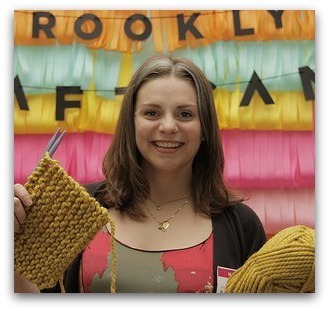 Kate McKean (@kate_mckean) is Vice-President and Literary Agent with the Howard Morhaim Literary Agency. She will open to queries again in the new year and is especially looking for contemporary YA and Middle Grade fiction. Visit her website.
Kate McKean (@kate_mckean) is Vice-President and Literary Agent with the Howard Morhaim Literary Agency. She will open to queries again in the new year and is especially looking for contemporary YA and Middle Grade fiction. Visit her website.
 Kevan Lyon (@KevanLyon) is a founding partner of Marsal Lyon Literary Agency. Kevan handles women’s fiction, with an emphasis on commercial women’s fiction, young adult and new adult fiction and all genres of romance. Her list includes NY Times and USA Today bestselling author Jennifer L. Armentrout, bestselling author Katie McGarry, Brittany Geragotelis, Cayla Kluver and Colette Ballard.
Kevan Lyon (@KevanLyon) is a founding partner of Marsal Lyon Literary Agency. Kevan handles women’s fiction, with an emphasis on commercial women’s fiction, young adult and new adult fiction and all genres of romance. Her list includes NY Times and USA Today bestselling author Jennifer L. Armentrout, bestselling author Katie McGarry, Brittany Geragotelis, Cayla Kluver and Colette Ballard.
The post Should Children’s Book Authors Self-Publish? appeared first on Jane Friedman and was written by Sangeeta Mehta.
November 23, 2014
5 Free WordPress Themes for Writers

Note from Jane: On Monday (Nov. 24), I’m teaching a live, 2-hour online tutorial on how to get your website up and running with WordPress. You don’t need have any previous tech experience—just a willingness to learn. Click here to find out more.
If you have a WordPress-based site, then you know that one of the first choices you have to make (and then live with) is your choice of theme. A theme drives the aesthetics of your site—how it looks and feels—and thus its personality.
But a theme also affects the functionality of your site. Some themes have more page or post templates than others. Some have very specific ways of formatting the homepage. Others allow for special customizations.
I use a simple, free theme for this site—TwentyTwelve—that’s developed by WordPress itself. It offers very few bells and whistles, but it’s served me well for a couple of years now. If you’re looking for your first WordPress theme, or you’re just in the market to redecorate, then consider these themes, which can work well for writers.
1. Penscratch
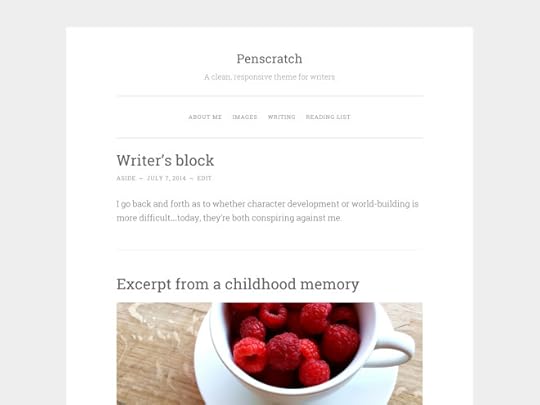
This theme (also developed by the folks at WordPress) has become a favorite with my students. The typography and white space are friendly, inviting, and easy on the eyes. It’s ideal for writers because the focus is the text. Go view the demo. Even though the demo shows you the theme in full-width mode, you can also add a sidebar.
2. Hemingway Rewritten

If you have beautiful photographs or imagery to incorporate into your site, check out Hemingway Rewritten. As the theme name indicates, it’s great for writers, but it also has a lot of opportunity for visual customization, so you can incorporate your own voice and personality. Go view the demo.
3. Editor

Editor is focused, minimalist, and ideal for get-to-the-point sites. If you’re intimidated by too many options and too much flexibility, this may be perfect for you. It’s intended for blog-driven sites, but looks good even if you don’t blog. Go view the demo.
4. Reddle

Reddle has a lot in common with Penscratch—and is also designed and developed by the folks at WordPress. It offers a gorgeous minimalist theme for bloggers, but can also be configured into a very simple, static-page site. Go view the demo.
5. Responsive

Responsive is far more customizable and complex than the other four—and more suited toward entrepreneurial and business-like authors. It offers numerous page layout options, a homepage template that’s ideal for showcasing books and products, and a double menu at the top. Go view the demo.
What WordPress themes do you use or recommend? Please share in the comments.
Note from Jane: On Monday (Nov. 24), I’m teaching a live, 2-hour online tutorial on how to get your website up and running with WordPress. You don’t need have any previous tech experience—just a willingness to learn. Click here to find out more.
The post 5 Free WordPress Themes for Writers appeared first on Jane Friedman and was written by Jane Friedman.
November 18, 2014
Finding More Readers Through Wattpad

Note from Jane: Today’s guest post is by Anne Pfeffer (@AnnePfeffer1), an author of several YA and new adult novels.
As the author of three indie novels, I was looking for ways to expand my base of readers. This blog’s very own Jane Friedman suggested that I try Wattpad, an online writing community where authors post their work for free. In April 2014, the site reported 35 million unique visitors per month, which is a lot of exposure for one little indie book, if you can get people to find it. The problem is, they also have over 1,000 story uploads per day, so the fight for reader attention is fierce.
In June 2014, I posted a portion of Any Other Night, a YA coming-of-age novel that I’d published in 2011. Then I waited.
To be perfectly honest, nothing much happened. That is, until August, when I was contacted by a content specialist from Wattpad. He said he’d read the first half of my book, which was all I’d posted at that point, and wanted to include it in their Featured Story section. He asked me to post at least two-thirds of my chapters before the date I was scheduled to debut on the list. Later, I could upload the rest of the chapters.
When you are featured, your book appears on the first two pages of the Featured Story list for a full two weeks. This makes it highly visible to all those millions of Wattpad readers. Almost immediately, Any Other Night went from nowhere to the Top 20 of Wattpad’s What’s Hot list for general fiction. I also started getting comments from readers.
The Wattpad system allows you to reply to comments and also to check the commenters’ profiles to see if they’ve been voting for you and on which chapters. While comments are fun, you live and die by the number of votes you get, which determines your position on the What’s Hot lists.
The period of optimal vote-getting is while you’re still posting chapters and readers are all excited and waiting for your next installment. It took me six or seven weeks to post my final chapters, during which I reveled in the experience of being scorching hot.
You’re allowed, by the way, to vote for yourself and to ask your friends and family to do the same. If you’re smart about it, you’ll get your supporters to vote all on the same day, which is more likely to send you flying up the hot list. They must have read your book, though. Soliciting votes from people who haven’t is cheating! For more on this, visit Wattpad’s post on how to hit the hot list.
I’ve stabilized, at least for now, in the top hundred of the list, so I guess I’m still pretty hot. My current number of reads is over 230,000, which is small for Wattpad, but huge for me.
To answer the question I know is on your mind, I did not get a lot of sales from all this. But I did see an increase to my “added” and “to be read” categories on Goodreads. More important, I have thousands of new readers from all over the world!
As I mentioned earlier, Wattpad reviewed my book on its own and approached me with an offer to feature it. However, they also entertain author requests. My experience has made me really appreciate Wattpad and the fact that it looks for and showcases little-known books it thinks deserve attention.
The post Finding More Readers Through Wattpad appeared first on Jane Friedman and was written by Anne Pfeffer.
November 13, 2014
Advice for Undergrad Students Pursuing a Creative Writing Degree

Even though I’ve been actively teaching in the university setting for more than 10 years, I’ve nearly always been in front of non-writing majors. (Right now, at the University of Virginia, I teach media studies majors.)
However, my undergraduate degree is a BFA in creative writing, and recently the AWP approached me to write an essay offering advice to undergraduate students pursuing that same degree. You can now read it over at AWP’s site.
Here’s a little bit of what I had to say.
“If it were up to me, every undergraduate writing program would help their students better understand the economics of the writing life and how authors or artists do manage to put together a full-time living from doing what they love. It is possible, but instruction and mentorship surrounding these issues remains rare in traditional programs. So it is up to you, dear student, to demand it from your program and its professors, or find it elsewhere.”
I do find it telling (and unfortunate) that my skills and abilities have so far been most highly valued by university degree programs not directly related to creative writing or English. Maybe that will change in time.
The post Advice for Undergrad Students Pursuing a Creative Writing Degree appeared first on Jane Friedman and was written by Jane Friedman.
November 11, 2014
Stephen King Still Fears Failure. How About You?

by Oscar Oliva OA / DeviantArt
Today’s guest post is by freelancer and author Marcy McKay.
The November 2014 issue of Rolling Stone interviews the master of contemporary fiction, Stephen King. The Q&A covers a myriad of interesting topics for writers: the author’s typical working day, his literary legacy, as well as how alcohol and drugs affected his writing back in the day.
However, one quote in particular shivered through me. It might change your thinking, too.
The interviewer casually asked him, “You still fear failure after all these years of success?” King replied:
“Sure. I’m afraid of all kinds of things. I’m afraid of failing at whatever story I’m writing—that it won’t come up for me, or that I won’t be able to finish it.”
Holy apostrophe, Batman! Stephen X@#% King still battles fear?
After four decades of publishing, with over 350 million books sold (both fiction and nonfiction), and winning the National Book Foundation’s Medal for Distinguished Contribution to American Letters—that guy still combats fear?
One writer-friend read that quote and bemoaned how it was hopeless for the rest of us. We’d stay buried in self-doubt forever.
Wrong attitude.
Those same 33 words freed me.
Learning from the Master
King fully admits his self-doubt. He worries his imagination will never even show up to the page, or worse, he won’t find the perfect ending for himself or his audience.
Hmmm, that sounds pretty much like the rest of us.
I know, I know, most of us will never be as prolific as the author of Carrie, Stand By Me and The Green Mile. We’ll probably never pen our memoir and a precise how-to that becomes a classic like On Writing.
It should still give us hope. Endless.
What Stephen King Teaches Us
King’s comments on fear offer three important takeaways:
1. Fear is part of the creative process.
We’ll never graduate and move on from fear like we did from high school. It’s a shadow always lurking behind us. It’s a horrible enemy that must be slayed over and over again.
2. Name your fear to destroy it.
Examine your fear to find the wisdom there. Look for specifics in your creative monsters.
Do you struggle with self-doubt like King? If so, at which stage? The beginning, the middle, the end, or all of the above? If so, be prepared, then ignore it and keep writing.
Is perfectionism a problem for you? Do you throw out draft after draft of your manuscript because it’s never good enough? Maybe you spend two hours rewriting one sentence? Striving for excellence is admirable, while perfectionism is damaging.
Are you a procrastinator? Do you keep telling people you’re still conducting research for your book when the truth is you’re too scared to start?
Do you sabotage yourself with alcohol or drugs to the point you can’t write? Do you create drama in your life instead of in your stories? Are you whiner who always talks about writing, but never writes?
3. Stop resisting fear.
Now that you understand fear part of the creative process, stop fighting it. Learn your internal/external signals as to what’s happening, and use it to your advantage.
Don’t misunderstand me: Even when you realize fear is part of the writing process, it will still scare the hell out of you. Each and every time. Except now, you’ll know what to do.
Shut up, sit down and write.
Do not wait to gather your courage first, then write. Write first to make the fear go away. Until it returns again. Then, you write through it once more.
The cycle repeats itself endlessly.
Why do we torture ourselves like this?
For that, we return to the Rolling Stone article: The interviewer asked King about retirement, if he saw himself still writing into his eighties and beyond.
King’s response was perfect.
“It (writing) fulfills me. There are two things about it I like: It makes me happy, and it makes other people happy.”
The post Stephen King Still Fears Failure. How About You? appeared first on Jane Friedman and was written by Marcy McKay.
November 3, 2014
How to Reveal Character Emotion Without Venturing Into Cliché

John Thornton Williams
One of the most important goals of any fiction writer is getting the reader to connect on an emotional level with the story’s characters.
But how do you accomplish this without being clumsy—without saying, directly, “Joe felt so upset he wanted to die,” which takes you right into the heart of cliché?
John Thorton Williams offers this suggestion:
[Take] into consideration how a certain character would experience a particular setting or image based on his/her emotional state. Something as simple as a car parked on the street surely looks different to a lottery winner than to someone who just got evicted. In other words, indirection of image is a way to take abstract emotions and project them onto something concrete. Doing so creates the potential to explore interiority at a greater depth than what’s afforded by mere exposition.
Williams goes on to show a specific example from William Gay’s fiction. Click here to read the full piece over at Glimmer Train.
For more writing advice and inspiration from Glimmer Train, check out these pieces:
My City (or, On the Idea of Making It My Own) by Aurelie Sheehan
Puzzle and Mystery by Peter Turchi
The Creative Process: A Diuretic Metaphor by Greg Schreur
The post How to Reveal Character Emotion Without Venturing Into Cliché appeared first on Jane Friedman and was written by Jane Friedman.
October 30, 2014
You’ve Got Hate Mail: How to Deal with (Annoying) Critics

ell brown / via Flickr
Note from Jane: Today’s guest post is by publisher and author L.L. Barkat (@llbarkat). She has one of the most gracious and welcoming personalities in the online space—so I’m delighted she’s written about how she maintains a calm and open demeanor even when faced with difficult or antagonistic personalities.
In a career decision that might look, to some, like a reversal of my call for many experienced writers to stop blogging, I recently took an unpaid position as a Huffington Post Books blogger. I’ve never claimed to be predictable.
One of my first tasks, apparently, was to find a critic—a confident person who would tell me my post on The Capitalistic Quandary of Poetry was no “call to arms” and that the post had used a straw man argument, because all I did was present an overview of what’s been happening with poetry over the last few years. I did not, it was pointed out, delve deeply into the issue of capitalism and poetry. Furthermore, my critic asserted, it was a tenuous job indeed, to use something against itself (in this case, to use anti-capitalism to promote a capitalistic advance).
I’ll let any further details rest. The key is my critic was unhappy and somehow also managed to cap the comment with what could potentially be perceived as a condescending recommendation for what I might want to write about in the future, since I seemed to be “clearly enthusiastic about poetry.”
I might. Be enthusiastic about poetry, that is. This could be required for the owner of a small press that actually publishes…poetry. It might be a necessary qualification for the managing editor of a large poetry site that covers, among other things, the issues this critic felt I should put my hand to (particularly how to teach poetry more effectively). Enough about me. Let’s talk about my critic (and yours).
Now the first thing you have already ascertained is that I have no problem with a writer being annoyed with his or her critics. I think it is obvious that, whether or not it is justified, I was initially annoyed with mine. The act is not called criticism for nothing, and there is every reason to dislike or be irritated by it. See Merriam Webster, and you might agree:
crit·i·cism: the act of expressing disapproval and of noting the problems or faults of a person or thing
Add to this that the critic has, too often, not taken the time to separate the person (you) from the critique, and has not seen it as his job to say anything complimentary along the way, and you have something potentially hurtful on your hands. So the role of maturity must fall to you (and me). What do we do when we attract a critic?
1. Let them charm you.
I like to remember that just as my critic has only stepped into a slice of my life and my thinking, so have I, through their comment or review, only stepped into a slice of theirs. I view myself as fairly charming, but in the case where I’ve attracted a critic, I’ve not managed to charm. My critic has the same issue in regards to his relationship with me—I am not charmed. But I could be, given a little humanity.
For my own career, and for all of the authors who work with us at T.S. Poetry Press, I recommend stepping back and remembering the bigger picture. Who knows what’s going on with our critics? The writing touched something inside them, and they responded. This doesn’t make them the bad guys, and if we met them under any other circumstance, we might easily be having coffee and sharing laughs.
2. Ask good questions
The critic has zeroed in on something interesting, no doubt (and, in a bit of irony, may really need to write about it!). If you feel like engaging, why not ask questions, like: If it was your piece, how would you have structured it differently? If you were to argue for xyz, what would you highlight instead? Did you find anything of value in the piece, and, if so, what was it? What is your interest in this aspect of the topic (the part being critiqued), and why?
3. Understand the compliment
In a piece called The Perverse Monstrosity of Our Beautiful Art, I once played with the idea that criticism is a form of compliment. It means we have chosen a topic worth discussing (or painting, or building) and done it in such a way that has actually had an impact, albeit not a positive one for the critic. Bland ideas, useless ideas, completely confusing ideas, these rarely draw criticism. They aren’t worth a critic’s time. Take the compliment.
4. Don’t retaliate
Stalk your critic? I don’t recommend doing what this writer has done, unless you plan on writing about it in The Guardian. But every day, writers retaliate in less complex ways. You might view the piece I am writing now as a form of retaliation. If so, I might end up asking you why. In my view, retaliation aims to hurt the critic rather than engage with what the critic has said, or use his or her comments to learn something. Real retaliation results in more pain and no illumination. Just don’t.
5. Re-evaluate why you write (for dialog, or approval?)
In the book Creativity Inc., Ed Catmull of Pixar discusses their director’s notes meetings, which can feel highly conflictual but are absolutely necessary for building the best movies they possibly can. His advice? See alternate opinions as additive versus competitive.
Sure, your critic may not have couched his opinion in a palatable form, but that doesn’t mean it’s not additive. I like to consider what the critic has just added to a conversation I started (and which, if I understand my place properly, I realize is also something additive, unless I am discussing alien matters from the outer limits of the universe, as yet untouched, unknown.)
If you are writing for approval rather than dialog, it can be very difficult to see a critic’s words as additive. Of course we all love approval, to varying degrees, but if that is the center of the reason we write, we might want to avoid writing for platforms that tend to draw more critics, and, if we are an author, we might decide not to read our reviews. I’m not going to suggest that it’s a bad idea to write for approval; writing appeals to various writers for different reasons. I am going to say, “Know thyself.” Act accordingly. And maybe at least consider how critique can be additive.
I am considering going to AWP this spring. Word has it my critic might be there. I’m thinking to invite her to coffee—and poetry.
The post You’ve Got Hate Mail: How to Deal with (Annoying) Critics appeared first on Jane Friedman and was written by L.L. Barkat.
October 29, 2014
Indies & Audiobooks: An Alternative to ACX
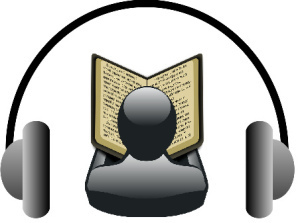
neinarson / via Flickr
Note from Jane: Today’s guest post is by novelist Lee Stephen (@epicuniverse).
Like many an independent author out there, I blazed the indie trail out of a love for the artistic side of things and an understanding that total creative control could result in better projects. And like my fellow indies, I soon realized that Amazon could be an outstanding ally. Their platform for self-publishing was second-to-none, and it enabled us to pack the wagon and head out west (figuratively speaking) to the wild frontier of doing-it-oneself.
So naturally, with audiobooks starting to catch fire, Amazon was poised to once again be our faithful companion. Right?
Right?
Not so much.
What Are the Terms of Amazon’s ACX?
The knocks on Amazon’s ACX platform have been duly noted in numerous blogs across the web. They keep either 75% or 60% of your profits, depending on whether or not you value the privilege of selling your own material. They require you to sign a contract that handcuffs you to your decision for the next seven years, after which they set the price of your work.
When I set out to create an audiobook for the first novel in my Epic series, Dawn of Destiny, I had done no research on the actual selling of an audiobook. I only knew that I wanted mine done differently. I wanted fans to hear it all and feel it all, like going out to see a summer blockbuster that happens to not have a screen. I hired 32 voice actors, packed the project with bombastic music and sound effects, and came out with an audiobook that sounded like Independence Day. It underwent nearly five years of development and cost more than most people would dream of spending on an audiobook. When it was finished, I was proud of it. This was different. This was new. This was what being an indie was all about. The only thing left for me to do was sell it.
Excited, I ventured into Audible territory.
Needless to say, what I found there devastated me. After five years’ worth of effort, ACX was offering me a mere spoonful of the feast I’d prepared. There had to be an alternative. There had to be a better way.
So I looked. I looked, and I looked, and I looked.
I found CD Baby.
Important note: Before I get into this, I want to make it clear that I do not work for CD Baby. No one from CD Baby has asked me to do this, and CD Baby is not paying me for this. They don’t even know that I’m doing it. I feel these facts must be mentioned beforehand, because things are about to get all warm and fuzzy!)
What Is CD Baby?
I was surprised when CD Baby ended up on my list of places to look into, as audiobooks are not what they do. But apparently, a handful of authors had taken a stab at their services, and from what I could find, no one had much to complain about. Just the same, there wasn’t a whole lot of information out there regarding CD Baby as an audio distributor.
I simply had to investigate.
One hour later, I was sold.
For those who know CD Baby, you know that they pride themselves on being a platform for indie musicians. For those who haven‘t heard of CD Baby, you might be surprised to find out that they’re exceedingly influential in the music industry for the aforementioned reason. Every indie band knows CD Baby.
But I’m not a band. I’m an author. But I’m producing audio, soooo…a phone call was in order.
Several minutes later, I was talking to a person.
Stop right there. Did you catch that? I’ll repeat it again, just in case, because this is actually kind of mind-blowing to anyone who’s needed desperately to talk to someone from Amazon in a pinch.
Several minutes after calling CD Baby, I was talking to a person. Not a sales rep. Not someone with English as their third language. A helpful human being who had the ability to answer my questions, help me set up a profile, then look at said profile to make sure it was the way I wanted. A person who loved their job.
An indie.
This helpful human being then informed me that, yes, while audiobooks weren’t their typical product, they still had worked with some audiobook producers in the past. They informed me that, yes, I could set my own release date and price. Yes, I could have links to my CD Baby store anywhere. Yes, I would keep a majority of the profit. 91% of it! No, there were no binding contracts. I could cancel, change the price, pull the product, or change any of its information, anytime I wanted.
It was my product.
Audio Quality of CD Baby Versus ACX
Did you know that Audible doesn’t upload audio files at their highest level of quality? Audible Enhanced Audio uploads at a sample rate of 22.050 kHz. This is what they consider CD quality. Funny enough, though, the rest of the world considers 22.050 kHz to be “low fidelity,” and 44.1 kHz to be CD quality, which is the level of quality that CD Baby makes available to the consumer.
Audible also requests that all uploaded files be in mono, not stereo, meaning there’s literally no depth of sound coming from Audible files.
It goes without saying that CD Baby, who specializes in digital audio, uses stereo. In layman’s terms, what does this mean? It means Audible files don’t sound as good. And by “don’t sound as good,” I don’t mean at a level at which only composers and dogs can differentiate. I mean noticeably not as good. I’m getting ripped off not as good. You can’t even find websites that audibly compare 22.050 kHz to 44.1 kHz, because it’s not even a debate.
But What About Distribution?
CD Baby can distribute your audiobook to iTunes and Amazon, with the caveat that it will not show up in the audiobook category, but in the “spoken word” category of music.
I do not recommend doing this, especially if you’ve invested as much as I have in your audiobook production. Though both iTunes and Amazon will respect the release date and pay a higher percentage of the profit than they would an audiobook, they will still not respect the price you’ve set for your product through CD Baby. Your audiobook will get listed for $8.99. Thus, I am only allowing digital distribution through CD Baby itself.
Crunching the Numbers
My research revealed that the average price of an audiobook on Audible’s Top 20 was $33.68, with a high listing of $69.97 and low listing of $19.93 and $19.95 (the next lowest after those was $22.67, then everything was mid-$20s and way, way up).
I listed Dawn of Destiny on CD Baby for $25.99. This was $7.68 less than the average, and it would have made Dawn of Destiny the 5th cheapest audiobook in a list of twenty.
Now, all of these numbers are subject to slight change, both upward and downward, as Audible’s Top 20 fluctuates. But it gave me a solid variety of actual figures with which to set a list price.
Had ACX listed Dawn of Destiny themselves and set the price for $25.99, I would be making either $6.49 or $10.40 per sale depending on whether or not I wanted the ability to sell it myself. I would have signed away my rights to the project for seven years, having no control in any area of what happens with it. My product would have been delivered to the consumer at a sound-quality level that isn’t even used in side-by-side comparisons because it’s just that poor.
At CD Baby, none of the negatives in the aforementioned paragraph are an issue, and I make a profit of $23.65 (91%) per audiobook sold while selling it at nearly 25% below the average audiobook price.
What About Visibility to the Market?
You might wonder about the wide exposure that comes with having something on Audible. To that, I would say that our fan bases are our exposure—the incredibly amazing people who follow us on Twitter, who like us on Facebook, who join our mailing lists, and who hound us for our next release dates. And they don’t care if you point them to Audible, CD Baby, or a shed in your backyard. If they follow you, if you’re fair to them, and if you reward them with quality material, they’ll make the purchase.
Final Thoughts
I’m pretty sure this was long so far as guest entries go, but I really am passionate about it, and it really is important. CD Baby has made me feel empowered as an indie audiobook producer. You deserve that feeling of empowerment, too. Don’t sell yourself (or your products) short.
I hope you enjoyed this entry and found it useful! I’d love to hear your thoughts on it. Feel free to ask me any questions about my CD Baby experience either below in the comments, on Twitter, or via email.
You can also check out the five-minute YouTube clip from my audiobook. I was aiming for something different, so let me know if I hit the mark (I do recommend headphones!). Or visit Dawn of Destiny‘s page on CD Baby.
The post Indies & Audiobooks: An Alternative to ACX appeared first on Jane Friedman and was written by Lee Stephen.
October 28, 2014
7 Reasons Twitter Isn’t Building Your Author Platform (And How to Fix It)
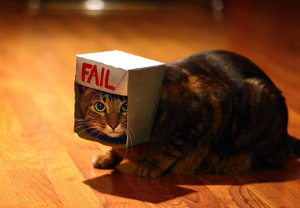
Chuckumentary / via Flickr
Note from Jane: Today’s guest post is by Marcy Kennedy (@MarcyKennedy).
Almost as soon as authors were told they should be on social media to build their platform, a counter-contingent of people started talking about how social media was a waste of time. They’d tell stories of using Twitter or Facebook or whatever the flavor of the month was and how they didn’t see any increase in sales or growth in their readership.
Usually there’s a simple reason for why social media didn’t work for them—they were doing it wrong.
I hope to save you some time and heartache by explaining seven of the biggest mistakes I see authors making on Twitter. When we use Twitter correctly, it’s still one of the best possible tools for expanding our reach.
Mistake #1: Using your bio as a sales pitch for your book.
Have you ever come across a Twitter bio that looks like this?
Author of 5-star #fantasy novel SKY DIAMOND available for #Kindle and #Nook. Passionate about #football, #dogs, and #running.
This bio scares followers away for a couple of reasons.
Adding hashtags into our bio makes it annoying for humans to read, and it suggests we’re going to spam them to buy our book as soon as they follow us.
Telling people how many stars our book has on Amazon, or saying it’s the best thing since The Hunger Games comes across as arrogant. People don’t buy books based on a Twitter bio. They buy based on interest in the subject matter or because they know and like the author.
Your bio should be about you. What do you write? How are you unique? What type of things will you regularly be tweeting about? That type of info makes people interested in following you and getting to know you.
Mistake #2: Automating everything.
Authors often set up a direct message to automatically go out to everyone who follows them, asking new followers to check out their book, visit their website, or like their Facebook page. Automating a direct message in this way is a bad idea. You immediately come off as a marketing bot rather than a real person.
Another automation trap is scheduling all tweets and never spending time on Twitter. I’m not against the occasional scheduled tweet, but be careful about it.
Here’s the crux of the matter: Scheduling tweets shouldn’t be used in place of actually being on Twitter and interacting. If we’re not there, we’re asking people to do something we’re not willing to do. We want to take from them, but we don’t want to give. What if everyone scheduled tweets but never spent time on Twitter? Who would see all those scheduled tweets?
Automating tweets can also lead to awkward situations. If everyone on Twitter is talking about a recent tragedy, and our Twitter account is spitting out self-promotion, it paints an unflattering picture.
A little authentic time on Twitter is better than a constant stream of automated messages.
Mistake #3: Protecting your tweets.
The point of social media is to be accessible. If we protect our tweets, we’re going to lose a lot of potential followers. Most people won’t go through the extra step of asking for permission to follow us. No one wants to take the risk of being rejected.
Mistake #4: Forgetting to have Twitter notify you when someone interacts with you.
Part of the challenge we all face with all social media is how to manage our time. So I make sure Twitter tells me when my tweets are marked as favorites, when I’m retweeted, when my tweets get a reply or I’m mentioned, when I’m followed by someone new, and when I’m sent a direct message.
By having notifications sent directly to my email inbox, I’m more able to be interactive without having to keep Twitter (or TweetDeck or Hootsuite) open all day. Plus, I miss fewer people who are trying to connect with me and the content I’m producing.
Mistake #5: Only tweeting about your book or your blog posts.
This is like being that person at the party who only wants to talk about themselves. Or who keeps trying to sell something (like the chocolate from their child’s school fundraiser). Everyone avoids those people. It’s the same on social media.
Our time on Twitter should be half conversation (building relationships), about 25% reciprocation (tweeting other people’s material), and 25% promotion of our books and blog posts. When we spend our time this way, the people we’ve built relationships with through conversation and reciprocation will retweet our tweets, amplifying our reach.
Mistake #6: Not using hashtags (or using them wrong).
Many people follow interesting hashtags by creating a column/stream for them. When we put a hashtag at the end of our tweets, that tweet is now seen by everyone who’s watching that hashtag, not just the people who follow us. Properly used, hashtags can expand our audience exponentially because we reach people who wouldn’t have known about us otherwise.
But here’s the catch. We can’t just slap a # sign in front of any old word and expect results. Not every potential hashtag is actively used and watched. We have to find ones that are. If we use abandoned hashtags, we might as well have not included a hashtag at all.
Make sure a hashtag is being used regularly either by researching it yourself (run a search through Twitter and see what comes up) or using a site like Hashtags.org.
Mistake #7: Not creating lists.
A Twitter list can be added to a column in TweetDeck or Hootsuite so that we’re able to watch the tweets from specific accounts that we’ve curated or selected (or that someone else has gathered). Twitter lists can help us make connections with agents, editors, or book reviewers; build relationships with other writers in our genre; keep track of subject matter experts; connect with writers who live in our area; reciprocate for people who regularly retweet our tweets; and stay in touch with fans who contact us about our books or say something good about our writing. Lists are an organizational and time management life saver.
Your turn: How do you feel about Twitter? What’s your biggest struggle?
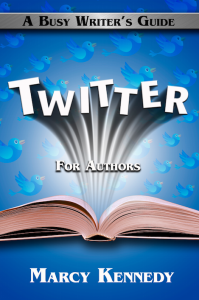 Note from Jane: If you found this post helpful, then check out Twitter for Authors: A Busy Writer’s Guide by Marcy Kennedy, available in ebook and print.
Note from Jane: If you found this post helpful, then check out Twitter for Authors: A Busy Writer’s Guide by Marcy Kennedy, available in ebook and print.
The post 7 Reasons Twitter Isn’t Building Your Author Platform (And How to Fix It) appeared first on Jane Friedman and was written by Marcy Kennedy.
Jane Friedman
- Jane Friedman's profile
- 1882 followers



